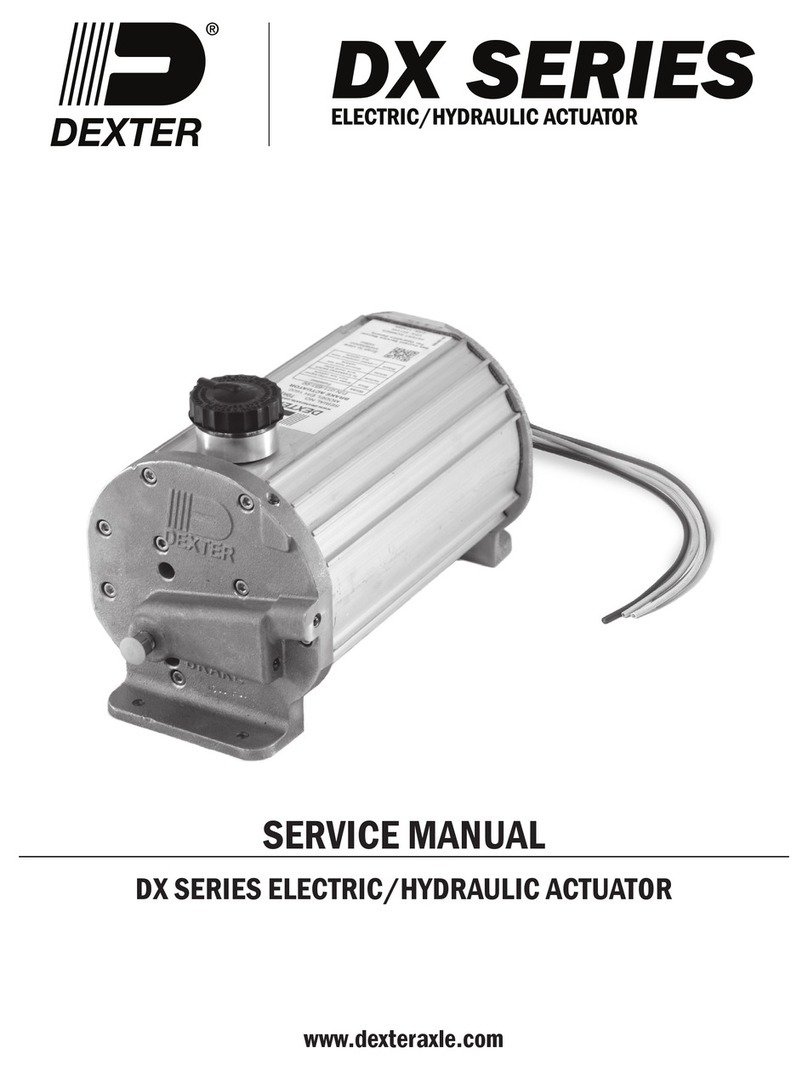
-2-
©2022 Dexter Axle Company | www.dexteraxle.com 059-A60-04 Rev. A | 2022.10
Attaching actuator to the tow vehicle using a multi-t coupler:
The multi-t (hand wheel) coupler will accept 1-7/8”, 50 millimeter,
and 2” diameter tow balls.
1. Open the coupler by depressing the hand wheel lock and turning
the hand wheel fully counterclockwise until its rotation is stopped
by the lock ring.
2. Lower the coupler onto the ball, conrming that the ball is fully
seated in the coupler socket. Tighten the hand wheel in a clockwise
direction to secure the ball. The hand wheel lock should click as
you turn the hand wheel, to conrm that the hand wheel will stay
tightened.
3. Turn the hand wheel until it can no longer be turned by hand, and
then back it off until the lock catches in the nearest notch on the
bottom of the hand wheel. Check that the ball latch has been
drawn up snugly under the tow ball, trapping it in the coupler
socket. Do not tow the trailer if the coupler is damaged.
4. Insert a standard padlock through the holes in the side of the hand
wheel, preventing the hand wheel from rotating and opening. Do
not use a padlock that interferes with the telescoping action of the
actuator.
Attaching actuator to the tow vehicle using a lever-lock coupler:
The lever-lock coupler is preset at the Dexter factory to t 2” trailer balls.
It can be adjusted to t 1-7/8” or 50 millimeter diameter tow balls by
tightening the coupler’s locknut, which is underneath the ball latch. After
adjustment, make sure that the sides of the locknut is trapped between
the anges of the lock plate so that the locknut can not vibrate loose
during trailering.
1. Open the coupler by pressing the handle assembly’s lock trigger
so it unhooks from the lock plate’s loop, and then by swinging the
handle forward.
2. Lower the coupler onto the ball, conrming that the ball is fully
seated in the coupler socket. Swing the handle upwards until
the lock trigger hooks onto the lock plate loop to secure the ball.
Check that the ball latch has been drawn up snugly under the tow
ball, trapping it in the coupler socket, and that the lock trigger
is rmly hooked onto the lock plate loop. A properly adjusted
lever-lock coupler will have between 1/64” and 1/32” of free
play between the ball and ball socket. Do not tow the trailer if the
coupler is damaged.
3. Check that the actuator’s coupler is securely latched onto the tow
ball by extending the trailer’s tongue jack to the ground. Use it to
lift the trailer tongue and tow vehicle hitch two to four inches. The
coupler and ball should remain engaged. DO NOT tow the trailer
unless the coupler is latched onto the ball securely. Retract the
trailer tongue jack before towing.
4. With the handle in the locked position, insert either a standard
padlock or spring pin through the hole in the side of the handle
assembly, locking the handle to the bolt. Do not use a padlock that
interferes with the telescoping action of the actuator.
Hitching Trailer
Attach the actuator’s breakaway chain S-hook securely to one of the tow
vehicle hitch safety chain connection points. Conrm that the trailer’s
safety chains are adjusted relative to the actuator’s breakaway chain as
noted above. DO NOT loop the breakaway chain around a bracket and
hook it back onto itself.
CAUTION
Safety chains must be used. The length MUST be set short enough
so the actuator’s breakaway cable is NOT pulled if the coupler
separates from the tow vehicle’s hitch but remains connected by
the safety chains.
Resetting the Breakaway Lever
The hydraulic pressure held in the system may cause the lever to snap
back quickly. Keep hands and ngers clear as you reset the breakaway
mechanism.
CAUTION
DO NOT use breakaway systems as a parking brake.
Remove the two screws which retain the cover over the breakaway
spring. This will allow the cover to be lifted. By pulling the breakaway
lever slightly further forward, you’ll be able to pry the breakaway spring
carefully out of the notch in the outer case to release the breakaway
lever. When removing the breakaway spring, be careful not to deform it.
CAUTION
An incorrect lever or chain position may cause the trailer
brakes to drag and overheat, or may keep the brakes from
being applied in a breakaway situation. After any usage of the
breakaway mechanism, either real or accidental, check all
system components for damage. Replace any damaged items with
genuine Dexter service parts.
Pre-Towing Check List
Check that the brake uid reservoir is 3/4- full of DOT 3 brake
uid. Check for leaks and repair as required.
CAUTION
Use only fresh brake fluid from sealed container. DO NOT reuse fluid.
Failure to maintain an adequate fluid level may cause brake failure.
Examine the actuator for wear, bent parts, corroded/seized parts,
or other damage. Have the affected components replaced with
genuine Dexter service parts. Check to determine that the actuator
mounting bolts are torqued to 80 ft.-lbs.
Test the actuator and brake function as previously described.
Actuator travel over 1” indicates that the brakes need adjustment.
Adjust the brakes according to manufacture instructions if needed.
There are no adjustments on the actuator.
A lm of grease on the hitch ball will extend coupler and ball life
while eliminating squeaking. Wipe clean and renew lm each time
trailer is used.
Before storage or after extended use, Dexter recommends applying
motor oil to the coupler components, lockout mechanism, and the
three internal rollers to keep them moving freely and to prevent
corrosion.





















